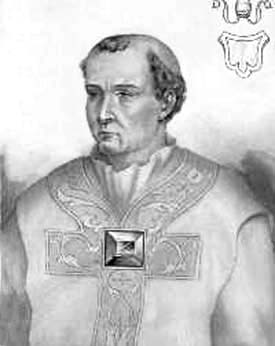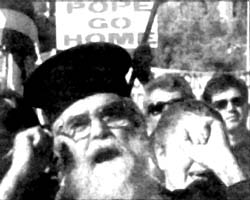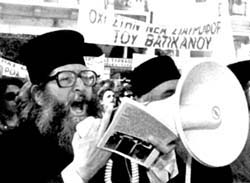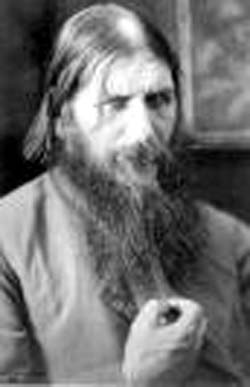 |
The Saint of the Day
Pope St. Nicholas I – November 13
Prof. Plinio Corrêa de Oliveira
Biographical selection:
St. Nicholas was Pope from 858 to 867. He was distinguished for his piety, benevolence, ability, knowledge and eloquence from an early age. He was considered a friend of the poor, protector of the widows and orphans, and zealous guardian of all the people of Rome.
He lived in difficult times. Corrupt princes were persecuting the good Bishops, often expelling them from their sees and replacing them with unworthy sycophants and men revolted against the Pope.

Pope St. Nicholas the Great |
Pope Nicholas I fought against those tendencies. The most important act of his pontificate was the condemnation of Photius, the schismatic patriarch of Constantinople. A part of the sentence of condemnation he issued follows:
“It is now clearly demonstrated that Photius took part in the schism. He left the world to be ordained bishop by Gregory of Syracuse, who had been deposed and excommunicated some time before. Like a thief in the night who enters the flock to steal away sheep, he usurped the See of Constantinople from our Brother Patriarch Ignatius. Afterward, he joined those who had condemned our Predecessor of happy memory, Pope Benedict. Breaking his word, he convened a council in which he dared to anathematize and depose our Brother Patriarch Ignatius. Acting against the law of the peoples [Jus gentium], he corrupted the emissaries of this Holy See and obliged them to scorn and disobey our commands. He persecuted - and to this date still persecutes - the Church, and ceaselessly inflicts terrible sufferings on the Holy Patriarch Ignatius, our Brother.
“By the authority of Almighty God, the Apostles Sts. Peter and Paul and all the Saints, and the six General Councils, the Holy Ghost pronounces this judgment through us: Let this Photius, guilty of so many crimes, be deprived of every priestly honor and every ecclesiastical function.
“Let him be excluded without hope of re-entering the communion of the Church. Let him be anathematized without receiving the Body and Blood of Jesus Christ, except in danger of death.”
Comments of Prof. Plinio:
In this formula of excommunication, the invocation of authority that St. Nicholas I made is particularly grandiose. He placed himself before Almighty God and the procession of St. Peter, St. Paul, and all the Saints, and then, with a supreme security, he affirmed that the Holy Ghost was speaking through his lips. It is magnificent!
Also touching is the manifestation of mercy of the Church that appears after the rigorous sentence of excommunication. St. Nicholas I opens an exception for the guilty party to receive Communion in danger of death. It is a sign of how God acts; He is always willing to deliver a soul in the last moment of his evil existence. It reflects the harmonious balance between justice and mercy that always exists in the Catholic Church.

During John Paul II's visit to Athens, May 4, 2001, Schismatics priests led massive manifestations against the Papacy, accusing the Pope of being the Antichrist

CNN online, May 5, 2001
|
I would like to take this opportunity in which we just saw a Saint describing the evil of one of the founders of the Eastern Schism to deal with a problem that is becoming more frequent among us, given both the considerable number of Schismatics entering Brazil as well as the growing ecumenical atmosphere that comes from conciliar ecclesiastic milieus.
It should be remembered that this revolt of Photius against Rome in the 9th century was the origin of the Eastern Schism. Those same errors would continue for 200 years until Michael Cerularius, another patriarch of Constantinople, brought the revolt to a climax in 1054, when Pope St. Leo IX decided to cut him and his followers from the communion of the Church.
The condemnation of Photius by St. Nicholas I helps us to better understand the spirit of the so-called “Orthodox Church,” which many people do not envision correctly.
Normally, when dealing with Protestants who represent real Protestantism, we can see the atrocious lack of sacrality and the sense of the futility of their barren religious offices without any supernatural blessing. There is also something of laicism in the Protestants, even with their constant appeals to the Lord.
Then, when one goes to analyze the Schismatics, he sees that they have splendid cathedrals, a solemn liturgy, and brilliant vestments. They come from a distant past that makes them look untouched by the modern industrial world. Therefore, one can be led to think that they are less censurable than the Protestants, and perhaps even harbor a sentiment of admiration for them.
Further, in this post-conciliar ecumenical atmosphere one only hears good things about the Schismatics: they have a valid sacrament of Orders and consequently their other sacraments would also be valid; they have a certain devotion to Our Lady, and so on.

The gaze of Rasputin reflects Satanism
that can also be noted in other Schismatic ecclesiastics

Internet photos |
This text of St. Nicholas I gives me the opportunity to emphasize the deep hatred the Schismatics have for everything that is Catholic. They hate the Papal Monarchy and the hierarchical system of the Church; they are also touched by the occult and even something of Satanism, which reflects well on the faces of many of their ecclesiastics, Rasputin, for example.
There is, therefore, this constant flame of hatred against the Catholic Church that coexists with admirable exterior façades. Along with those appearances is an anti-hierarchical, egalitarian, and dissolute spirit that represents the true spirit of the Schismatic Church.
During the Crusades, the Schismatics were guilty of continuous acts of felony and treason. They pretended to make alliances with the Western Crusaders and then betrayed them to the benefit of the Muslims.
I read a description on the fall of Constantinople in the 15th century written by the Papal Nuncio who was present and managed to flee before everything was taken by the Turks. He described the terror of the Schismatics when the Turks broke into the city, destroyed a large number of buildings and monuments, and killed many inhabitants. He said that despite their fear, the Schismatics still maintained an enormous hatred toward Catholics. Then he speculated that even if a miracle would take place and the Turks would be expelled from the city, the Schismatics still would not convert.
Another point to consider is that according to their doctrine, the Schismatic religious authorities must be subordinate to the civil authority. This is an erroneous doctrine that had and still continues to have fatal consequences. For example, in the countries where a Communist regime is in power, the whole Schismatic Church automatically places itself at the service of Communism. This is what happened with the Russian Schismatic Church and other independent Schismatic Churches of other Communist countries. They were drenched in Communism.
Finally, it is never enough to emphasize that the Catholic Church called them Schismatics because of the historic separation. But in fact they are worse than Schismatics, they became heretics insofar as they denied various dogmas of the Catholic Faith: the procession of the Persons in the Holy Trinity, the Immaculate Conception of Our Lady, Papal Infallibility, and the Petrine Primacy.
It is indispensable to keep these things in mind in our times of ecumenism that pretends that the Schismatics are very close to the Catholic Church.


  | | Prof. Plinio Corrêa de Oliveira | |
The Saint of the Day features highlights from the lives of saints based on comments made by the late Prof. Plinio Corrêa de Oliveira. Following the example of St. John Bosco who used to make similar talks for the boys of his College, each evening it was Prof. Plinio’s custom to make a short commentary on the lives of the next day’s saint in a meeting for youth in order to encourage them in the practice of virtue and love for the Catholic Church. TIA thought that its readers could profit from these valuable commentaries.
The texts of both the biographical data and the comments come from personal notes taken by Atila S. Guimarães from 1964 to 1995. Given the fact that the source is a personal notebook, it is possible that at times the biographic notes transcribed here will not rigorously follow the original text read by Prof. Plinio. The commentaries have also been adapted and translated for TIA’s site.
|
Saint of the Day | Home | Books | CDs | Search | Contact Us | Donate

© 2002- Tradition in Action, Inc. All Rights Reserved
|
 |

|